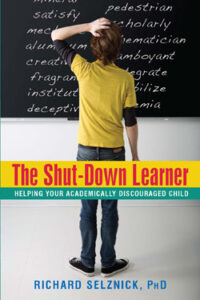My Interview with Documentary Film Director, Jamie Redford (#Dyslexia)
 (***This blog is a revision of an earlier post.)
(***This blog is a revision of an earlier post.)
Understanding dyslexia is challenging, primarily because of the deeply embedded mythologies that we hold. Chief among them is “the reversal thing.”
To illustrate, try this experiment. With any friend or relative ask them, “What do you know of dyslexia?” With pretty good certainty I predict you will get the, “Isn’t that when,” response, as in “Isn’t that when you read upside down and backward?”
It happens every time.
Not sure how we all got so hypnotized to believe that mythology, but of the last 100 or so dyslexic kids I evaluated, not one of them showed any sign of reading upside down or backward.
A few years back when I was doing my School Struggles podcast series as a part of The CoffeeKlatch Network I had the honor of interviewing James (Jamie) Redford, a documentary filmmaker, who had directed the award winning film, “The Big Picture: Rethinking Dyslexia.”
The interview centered on the struggles that Jamie and his wife, Kyle, had gone through in helping their son overcome his struggles with dyslexia.
James was warm, accessible and a pleasure to interview. I remember thinking at some point in the interview that I felt like I was talking with an old friend over a cup of coffee.
Sadly, James passed away in October of 2020 at the age of 58 from complications related to liver cancer.
In this replay of the interview, we think of Jamie and thank him for fighting the good fight.
Here is the interview:
Jamie Redford Interview: Rethinking Dyslexia
Feel free to make comment below.
To receive future blog posts, register your email: https://shutdownlearner.com.
To Contact Dr. Richard Selznick for advice, consultation or other information, email: shutdownlearner1@gmail.com.

 Copyright, Richard Selznick, Ph.D. 2023, www.shutdownlearner.com.
Copyright, Richard Selznick, Ph.D. 2023, www.shutdownlearner.com.

 Those of you following this blog for some time know there are some recurring themes in these posts (that mostly irritate me).
Those of you following this blog for some time know there are some recurring themes in these posts (that mostly irritate me). Not sure when the reverence for word problems emerged, but it seems that children are almost exclusively taught math through word problems. I believe it’s linked to the theory that math should always be enhancing “higher order thinking.”
Not sure when the reverence for word problems emerged, but it seems that children are almost exclusively taught math through word problems. I believe it’s linked to the theory that math should always be enhancing “higher order thinking.” Largely supported by the medical model, when parents have their child assessed they are often focused on “the diagnosis.” Such a model embodies a, “Yes, they have it,” or “No, they don’t have it,” (whatever “it” is) perspective.
Largely supported by the medical model, when parents have their child assessed they are often focused on “the diagnosis.” Such a model embodies a, “Yes, they have it,” or “No, they don’t have it,” (whatever “it” is) perspective. Practically every week I hear an array of concerns regarding distractibility and inattentiveness.
Practically every week I hear an array of concerns regarding distractibility and inattentiveness. Copyright, Richard Selznick, Ph.D. 2023, www.shutdownlearner.com.
Copyright, Richard Selznick, Ph.D. 2023, www.shutdownlearner.com. Anxiety over your child’s school-based problems can start very early. A mom recently contacted me after reading The Shut-Down Learner.
Anxiety over your child’s school-based problems can start very early. A mom recently contacted me after reading The Shut-Down Learner. Recently, 8-year-old Marty showed some signs of misbehavior when his mom exclaimed, “Boy, you’re in hot water now.”
Recently, 8-year-old Marty showed some signs of misbehavior when his mom exclaimed, “Boy, you’re in hot water now.”